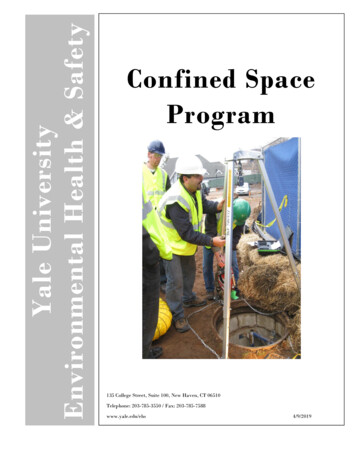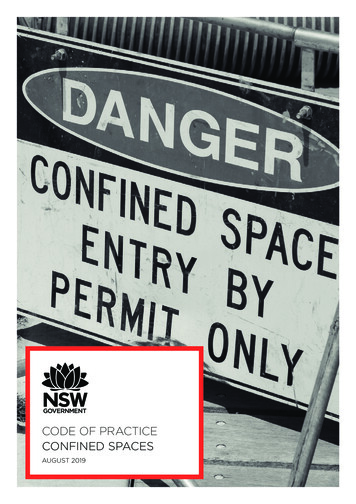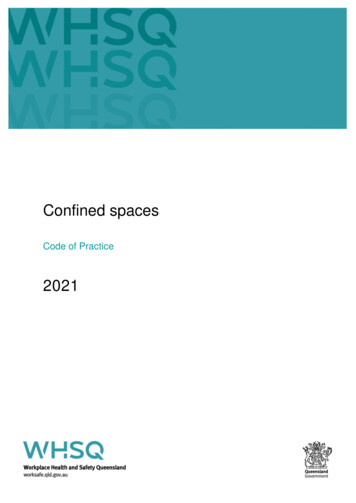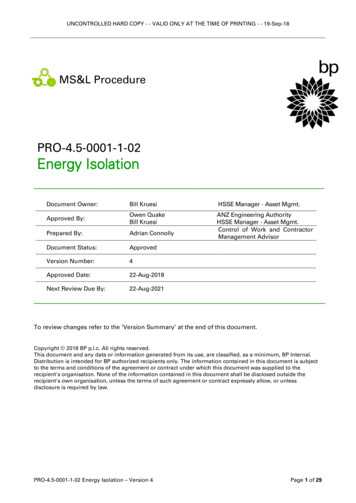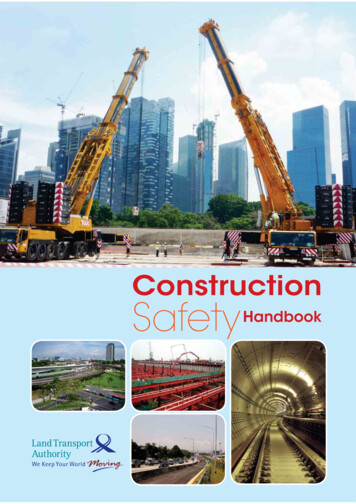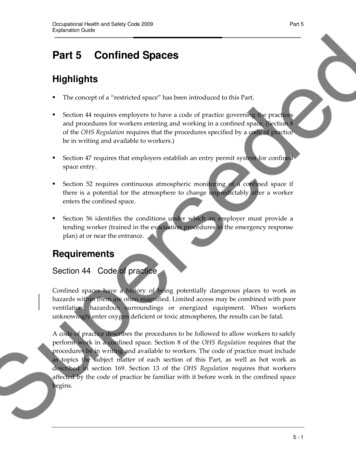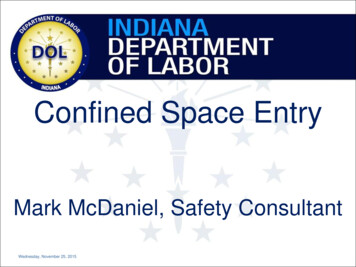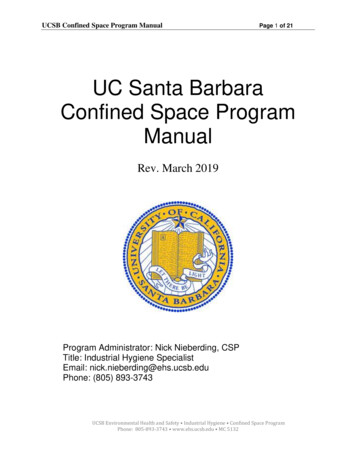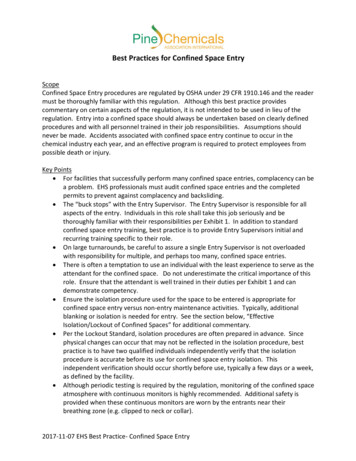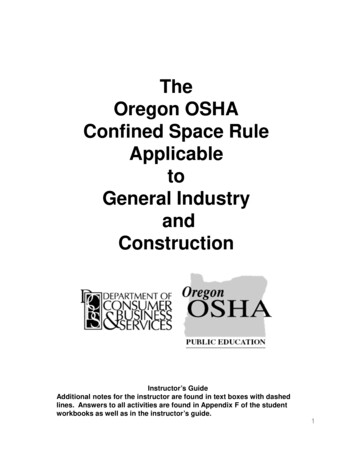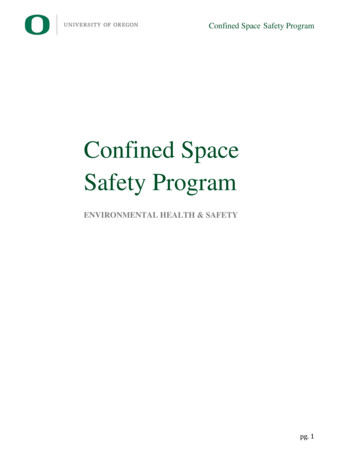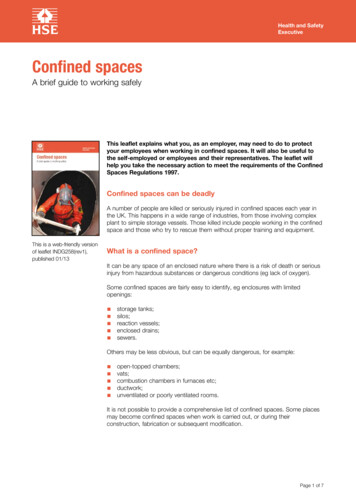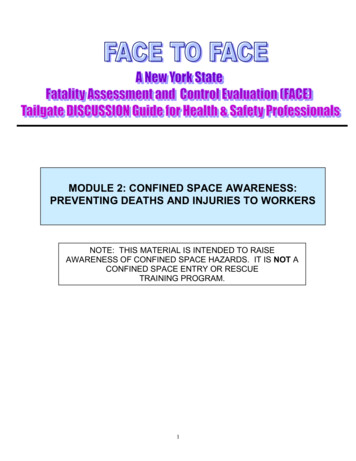
Transcription
MODULE 2: CONFINED SPACE AWARENESS:PREVENTING DEATHS AND INJURIES TO WORKERSNOTE: THIS MATERIAL IS INTENDED TO RAISEAWARENESS OF CONFINED SPACE HAZARDS. IT IS NOT ACONFINED SPACE ENTRY OR RESCUETRAINING PROGRAM.1
CONFINED SPACE AWARENESS: PREVENTINGDEATHS AND INJURIES TO WORKERSCurriculum Contents*I.Training CurriculumA.B.C.D.E.II.Getting StartedDefinitions and HazardsReal-Life Examples and DiscussionTalking PointsTake Away MessagesAppendix* THIS CURRICULUM IS NOT INTENDED TO TRAIN YOU TO BEAN ENTRANT OR ATTENDANT IN A CONFINED SPACE ENTRYOR TO PERFORM A RESCUE. THIS TOOL WILL HELP YOU TOIDENTIFY CONFINED SPACES SO THAT YOU WILL STAY OUT.2
I. Training CurriculumA. GETTING STARTED- Why is Confined Space Awareness aConcern?An average of 100 confined space related deaths occur each year inworkplaces in the United States. The main cause of the fatalities is workersentering oxygen deficient or toxic atmospheres. More than 60% of thedocumented deaths occur among would-be rescuers. Accidents thathappen in confined spaces are often fatal. This is why this topic is of suchconcern.The goal of this awareness material is to: Help workers to recognize what a confined space is, to identify theassociated hazards and to clearly understand that they shouldNEVER enter a confined space unless they have received appropriatetraining and the entry is in accordance with the employer’s writtenconfined space entry program. Assist employees in understanding the correct emergency responsein a confined space incident. A confined space workplaceemergency situation may generate spontaneous reactions that maylead to multiple fatalities. It is critical that workers know they shouldNEVER enter a confined space to rescue someone unless they arequalified Confined Space Rescue personnel. CALL 911 immediately!Don’t waste time.During the tailgate discussion, you will be providing your workers withinformation to identify confined spaces as well as the hazards that can bepresent in confined spaces. An additional example has been included inthe Appendix section of this guide.Read the “Hazard Warning” to workers as well as the questions andanswers in Section B. Provide your workers with a copy of the “SafetyChecklist For Confined Spaces” located on page 8.3
B. DEFINITIONS /HAZARDSHAZARD WARNING!DO NOT enter confined spaces as you are puttingyourself at risk of serious injury or death.Every year, many workers in the U.S. are injured or killed byentering or working in confined spaces. Confined spaces canbe found in many workplace settings. The hazards are generallydetermined by what is stored inside the space, by whatprocesses may be taking place inside the space as well as thestructure of the space. Hazards are generally atmospheric (air)or physical in nature.WHAT IS A CONFINED SPACE?ALL THREE CONDITIONS MUST BE MET:1. Is large enough for an employee to enter and perform work;2. Has a limited or restricted means of entry or exit; AND3. Is not designed for continuous occupancy by the employeeWHAT ARE SOME EXAMPLES? Sewers, Utility Vaults, Manholes, Storm Drains, Septic TanksTunnelsDegreasing TankBoilers, FurnacesTank CarsCisternsDrained Swimming PoolsPits, Pipelines, Pumping StationsSilos, Storage BinsTrenches, ShaftsWHEN MIGHT WORKERS ENCOUNTER CONFINED SPACES? As part of their work tasks: Inspection, repair, maintenanceNew constructionEmergency rescue4
WHAT MAKES CONFINED SPACES DEADLY? Hazardous air conditions such as: Too little oxygen Too much oxygen Flammable atmospheres, such as from methane or solvents Airborne combustion from dust or explosive gases Toxic chemicals such as hydrogen sulfide, carbon monoxide, or solvents Welding fumes Physical Hazards such as: Solid materials than can engulf and suffocate an entrant (loose materialsuch as sand, grain, silage, sawdust, coal) Liquid materials that can engulf and drown an entrant (water, sewerage) Space configurations that can trap an entrant (inwardly converging walls,sloping floors) Mechanical apparatus (gears, conveyors, mulchers) Electrical power Temperature extremes Poor visibility, lack of lighting Falling objects that can strike workers Fall and trip hazards (from lack of firm footing, obstacles, slick surfaces) Other hazards that would make escape or rescue from the area difficultACTIVITY:QUESTION FOR GROUP (READ ALOUD):About how many workers in the U.S. are killed each year after entering orworking in a confined space?a) 5b) 10c) 50d) 100ANSWER (READ ALOUD):Around 100 workers are killed in confined spaces each year in the United States.These workers leave behind many family members and friends. Around 60% ofworkers who die in confined spaces are people who rush in to help the firstvictim. The tragedy is that all of these deaths can be prevented.DISCUSSION QUESTION FOR GROUP (READ ALOUD): What areexamples of possible confined spaces in our workplace?5
SAFETY CHECKLIST FORCONFINED SPACESHAZARD WARNING!DO NOT enter confined spaces as you are puttingyourself at risk of serious injury or death.Here are some simple ways you can helpprotect yourself and your co-workers Know how to identify a confined space.NEVER enter an area that could be a confinedspace. Contact your supervisor or safetyrepresentative if you have any questions abouta space to be entered.Do not rely on your senses to determine if aconfined space has hazards. A number ofhazardous gases are both colorless andodorless.NEVER enter a confinedspace to try to rescueanother worker. Call 911.DO NOT RELY ON YOUR SENSES TO DETERMINE IFA CONFINED SPACE IS SAFE! TRAINED ENTRANTSUSE GAS METERS and SENSORS to DETERMINE6LEVELS OF SPECIFIC GASES.
C. Real-Life Example 1 and DiscussionA useful way to train workers about safety hazards is to present them withreal life examples. Read the example below aloud to employees. A copy ofthe full report upon which this example is based has been included in the“Appendices” section—“City Engineer Killed in Landfill Manhole whenRetrieving Flow Meter”. After reading the example aloud, use the questionsin the “Discussion” section to get workers to talk about why the accidentmay have happened.EXAMPLE 1 (READ ALOUD):In May 2003, a 32-year-old male city engineer collapsed in a manhole inNew York while attempting to retrieve a flow meter. On the day of theincident, the victim and one of his co-workers, as well as a student intern,drove to a landfill to replace a battery for a flow meter that had been placedin the manhole. They opened the manhole cover with a pickaxe and thevictim began to lift the meter out of the manhole when it fell to the bottom.The victim descended into the manhole to retrieve the meter. As he wasabout to climb the ladder out of the manhole, he lost consciousness. Thishappened so quickly, he lost consciousness in seconds. The co-workercalled 911 on his cell phone and the fire department responded withinminutes. The victim was removed from the manhole and was transported toa nearby hospital where he was pronounced dead. At the time of therecovery, the oxygen concentration at the bottom of the manhole was only2.1% (should be above 19.5%) and the flammable vapors exceeded 60% ofthe lower explosive level (should be less than 10%).7
C. Real-Life Example 1 and Discussion (cont.)Questions can be a good way to get people thinking about a lesson.During this part of the training, discuss what caused the confined spacefatality you just read. Listed below are questions you may want to askand some of the answers you are likely to receive.Because some workers might be hesitant to answer right away, you maywant to read one of the answers given below. Then, ask workerswhether they think the answer you gave was correct. However, don’tgive an answer right away. It is best to wait at least 10 seconds afteryou ask a question before you give an answer. People remember thingsbetter when they hear them many times or both hear and see it. Ifpossible, write down the answers workers give to questions on a largewriting board. Or, if writing is not possible, repeat the answers aloud.QUESTIONS AND ANSWERS (READ ALOUD):1.Q: Was the manhole a confined space?A:1. Was it large enough for an employee to enter? Yes2. Was it designed for limited or restricted entry? and Yes3. Was it designed for continuous human occupancy? NoAll three conditions were met. This space was a confined space.2.Q: What hazards were in this confined space?A: The space had a hazardous atmosphere of low oxygen level andflammable vapors and was immediately dangerous to life and health.Other physical hazards might include falls.3.Q: Should the engineer have entered the manhole when he dropped theflow meter?A: No. You should NEVER enter a confined space unless you are atrained and qualified Confined Space Entrant and your employer haspermitted this entry in accordance with the company’s ConfinedSpace Entry Program.8
4.Q: Should the co-workers have tried to rescue the victim?A: No, they too may have been injured or killed by the hazardous airconditions. NEVER enter a confined space to rescue another worker.They immediately called 911 as they should have. Remember inhazardous atmospheres, time is critical; only minutes are available.5.Q: Some hazards are not apparent to the senses such as low oxygenlevels. If you don’t see, smell, taste, hear or feel any hazards should youenter a confined space?A: No, NEVER enter a confined space unless you are a trained, qualifiedConfined Space Entrant. It is impossible to tell by smell or someother sense that the air is safe for entry. Many hazardous gases arecolorless and odorless. Not all chemicals or contaminants have an odor (e.g., carbonmonoxide). Some chemicals or contaminants can only be detected whensuch large quantities are present that your health is already indanger (e.g., ethylene oxide, isocyanates). Your nose can become desensitized to strong odors and youmay no longer smell it (e.g., hydrogen sulfide).6.Q: What risks have you encountered in your work activities? Discuss the actual work locations and situations you or your coworkers have encountered.9
C. Real-Life Example 2 and Discussion (cont.)A useful way to train workers about safety hazards is to present them withreal life examples. Read the example below aloud to employees. Afterreading the example aloud, use the questions in the “Discussion” sectionto get workers to talk about why the accident may have happened.EXAMPLE 2 (READ ALOUD):A foundry employee was working the graveyard shift performingmaintenance on a conveyor drive chain unit. The maintenance involvedspraying the drive chain with a degreasing solvent containing methylchloroform (chemical name: 1,1,1-trichloroethane). Methyl chloroformis heavier than air. Exposure to methyl chloroform can damage thecentral nervous, lung and cardiovascular systems. The conveyer chainunit was housed in a pit that was 28’ long, 14’ wide and 5’ deep with aladder on one side for access. He sprayed for an hour before thedinner break. During the break, he reportedly complained to his coworkers that the vapors were bothering him. He returned to the pit andcontinued spraying after the break.At the end of the shift, the victim was found lying on his sideapproximately ten feet from the ladder while the nozzle was stillspraying. There were about 10 to 20 gallons of solvent on the flooraround the victim. A supervisor first entered the pit through the laddertrying to rescue the victim. He was immediately overcome by the vapor.He fell to his knees, but was able to stand up and climb back up theladder. The supervisor and a co-worker then attempted to enter the pitwhile holding their breath, but again had to leave the pit. On the thirdattempt, they managed to remove the victim out of the pit. They startedresuscitation and continued until the emergency medical servicearrived. The victim was pronounced dead at the scene. The directcause of death was determined to be inhalation of methyl chloroform.10
C. Real-Life Example 2 and Discussion (cont.)Questions can be a good way to get people thinking about a lesson.During this part of the training, discuss what caused the confined spacefatality you just read. Listed below are questions you can ask and some ofthe answers you are likely to receive.QUESTIONS AND ANSWERS (READ ALOUD):1.Q: Was the pit a confined space? Why or why not?A: Yes, it meets the three criteria for a confined space.Review the three criteria of a confined space: Large enough to enter fully (the pit was 28’ long, 14’ wide and 5’deep); Not designed for continuous human occupancy (it was designedto hold the chain unit); and Limited or restricted access (there was a ladder attached to thewall).2.Q: What went wrong?A: The employee should not have been working in the pit. He hadexperienced warning symptoms, but didn’t report them to hissupervisor or to the safety representative. He went back into the pitdespite not feeling well. Co-workers didn’t stop the employee from going back into the pit. No one had received confined space awareness training There was no confined space program A risky rescue could have resulted in a multiple fatalities3.Q: What would you do if you were the supervisor and you observed thevictim lying in the pit?A: Call 911 immediately. Do not attempt to rescue the victim by entering the pit. Ensure no one goes down into the pit.4.Q: Have you ever been in a similar situation of risk? Discuss actual situations you or your co-workers have encountered.11
D. Talking PointsThe goal of this part of the review is to get workers talking about theirown experiences with confined spaces. Listed below are questions youcan use to get people talking and questions you can use to get people toprovide more details. You may also want to include information on theconsequences for employees who do not follow established safety rules(e.g., verbal warning for first infraction, written warning).QUESTIONS (READ ALOUD):What are some of the work activities you and your co-workers do thatinvolve confined spaces? Discuss. Are there other ways to perform the work activity that do not involveentering the confined space?Have you or anyone you know ever had an incident or near-miss incidentthat involved a confined space? What went wrong? What could have been done to avoid the incident?12
E. Take Away MessagesReview the “Safety Checklist for Confined Spaces” aloud (found afterSection B “Definitions/Hazards”). These are the key messages youwill want workers to have and remember. Once you have finishedreviewing the information, ask if anyone has any comments aboutthe advice. Finally, thank workers for their time and ask them tocomplete the evaluation form located on the next page.Evaluation forms should be returned to you. Completed formsshould then be sent to the NY FACE program. The evaluation willhelp us to improve this program and make it more useful to workers.New York FACE ProgramNew York State Department of HealthCorning Tower, Room 1325Empire State PlazaAlbany, NY 12237Or fax to (518) 402-790913
The New York State Fatality Assessment and Control Evaluation (NYFACE) program would like to know if this NY FACE Tailgate Trainingprogram was helpful to you. Please answer the questions below and returnthe survey to your training instructor. Your input and opinions will helpstrengthen our program and allow us to provide better information to youand others in the future. If you have any questions, or would like to report awork-related fatality, please call The Bureau of Occupational Health andInjury Prevention toll-free at 1-866-807-2130.Please help us improve our efforts to prevent worker fatalities byanswering the following questions about our NY FACE TailgateTraining program.1. How would you rate the NY FACE Tailgate Training program? Excellent Good Fair Poor2. How would you rate the amount of information in the course? Too Much About Enough Not Enough3. Did you learn anything new or useful during the Tailgate Training? Yes No4. What did you like most about the Tailgate Training?14
5. What did you like least about the Tailgate Training?6. How likely are you to change some of your work behaviors based uponwhat you learned during the Tailgate Training? Very Likely Somewhat Likely Somewhat Unlikely Unlikely7. Would you be interested in other safety trainings like this one related toyour job? Yes NoIf yes, do you have any suggested topics?8. Had you ever heard of the NY FACE program before attending thistraining? Yes NoIf yes, where did you hear about it?15
Thank you for your time. If you are interested in other NY FACEreports, please visit our web site at: ace/16
AppendixCity Engineer Killed in Landfill ManholeWhen Retrieving Flow MeterCase Report: 03NY027SUMMARYOn May 28, 2003, a 32-year-old male city engineer collapsed in a manhole whileattempting to retrieve a flow meter and was pronounced dead after he was transported toa hospital. On the day of the incident, the victim, a co-worker (an assistant engineer) anda student intern drove to a landfill to replace a battery of a flow meter that had beenplaced in a manhole. Once they arrived at the site, the victim opened the manhole coverwith a pickaxe. The manhole was 7’4” deep and 24” in diameter at the point of entry.There were four iron rungs mounted into the cement wall of the manhole to form aladder. The flow meter was attached to the top rung that was 34 inches below themanhole opening by a “U” shaped spring loaded handle. The victim used a hook made ofa wire hanger to catch a string that was looped and tied around the handle of the flowmeter. When he was pulling and lifting the meter, the weight of the flow meter causedthe wire hook to straighten and the meter fell to the bottom of the manhole. The victimquickly descended into the manhole to retrieve the meter. Once at the bottom, the victimpicked up and placed the flow meter on the top rung. Just as he was about to ascend, helost consciousness and collapsed in the bottom of the manhole. The assistant engineerimmediately called “911” on his cell phone. The fire department arrived at the site andimmediately started the confined space rescue procedure. The victim was extricated fromthe manhole in approximately 20 minutes. He was transported to a nearby hospital wherehe was pronounced dead. According to the fire department monitoring data, the oxygenconcentration at the bottom of the manhole was 2.1% and the flammable vapors exceeded60% of the lower explosive level (LEL) at the time of the rescue.New York State Fatality Assessment and Control Evaluation (NY FACE) investigatorsconcluded that to prevent similar incidents from occurring in the future, employersshould: Implement a confined space entry program for all workers who are or could beexposed to confined space hazards;Provide immediate training and periodic refresher training to all employees whomay be exposed to confined space hazards;Evaluate the sewer flow monitoring procedure and modify it to reduce workers’risk;Assign a trained safety and health professional to oversee the implementation andmaintenance of the city’s safety and health programs;17
Establish a centralized safety committee with both management and employeerepresentatives to assist in the development, implementation, and oversight of thesafety and health programs.INTRODUCTIONOn May 28, 2003 at approximately 2:30 PM, a 32-year-old male city engineer collapsedafter entering a manhole to retrieve a flow meter. He was extricated from the manhole bythe fire department and transported to a hospital where he was pronounced dead. NewYork State Fatality Assessment and Control Evaluation (NY FACE) staff initially learnedof the incident through a newspaper article on May 29, 2003. On June 17, 2003, two NYFACE investigators conducted an on-site fatality evaluation. During the site visit, theinvestigators met with the representatives of the city government that employed thevictim, interviewed the witnesses to the fatal incident, and inspected the landfill manholewhere the fatal incident occurred. Additional information was provided by the city policeand fire departments and the regional office of the Public Employees Safety and HealthBureau (PESH) of the New York State Department of Labor (NYSDOL). The policereport and Medical Examiner’s report were also reviewed.The victim’s employer, a city government, employed a total of 150 full-time and 70 parttime employees at the time of the investigation. Non-managerial employees wererepresented by four labor unions. The victim was classified as managerial personnel andwas not represented by a union. At the time of the incident, the city did not have a safetyand health professional on staff to oversee the implementation and maintenance of thecity’s safety and health programs. All the safety and health programs were administeredand maintained by individual department managers. The city did not have an activesafety committee at the time of the incident. According to the city administration, theengineering department where the victim worked did not have a confined space programnor did it provide employees with awareness training on confined space hazards.INVESTIGATIONOne of the tasks performed by the engineering department was to monitor the city’ssanitary sewer. Material from the city’s sanitary sewer was treated by a water treatmentplant in an adjacent town. As required by the town, the city had to monitor the sewerflow rate. The flow rate was monitored by battery-operated flow meters that were placedin three manholes: two located on a city street and one in an inactive landfill. Themonitoring procedure that started in the summer of 2002 included replacing therechargeable batteries every Wednesday and downloading the flow rate data everyFriday.The fatal incident occurred in the landfill manhole. The landfill was formerly a solidwaste management facility that was operated by the city until 1985 when it ceasedoperation. The manhole was a primary location that received the total leachate flow fromthe entire landfill. The flow meter had not registered any leachate flow since the18
monitoring started until the date of the incident when the monitoring was temporarilysuspended.On Wednesday, May 28th, 2003, the day of the incident, the victim drove the assistantengineer and the intern to the manhole locations to replace the flow meter batteries. Priorto the incident, they had finished changing batteries on two of the three flow meters. Atapproximately 2:30 PM, they drove to the landfill to replace the last battery. They parkedthe city vehicle at the landfill entrance and walked approximately a quarter mile throughthe field toward the manhole located on the south side of the landfill. The victim wascarrying a pickaxe and the intern the spare battery. Once they arrived at the manhole, thevictim mentioned that there should be a wire hanger lying on the grass somewhere that heused to assist in lifting the meter out of the manhole. He searched and found the hanger.The victim then opened the manhole cover with the pickaxe.The manhole was 7’4” deep and its inner diameter was 24” (Figure 1). It looked dry atthe time of the incident according to the witnesses. There were four iron rungs mountedinto the cement wall of the manhole to form a ladder. The flow meter (Figure 2),weighing approximately 15 pounds, was attached to the top rung (34 inches below themanhole opening) by means of a “U” shaped spring loaded handle. A string was loopedand tied around the handle of the flow meter.Figure 1. The landfill manhole where the fatality occurred.After removing the manhole cover, the victim proceeded to retrieve the flow meter. Heknelt next to the manhole opening and reached down with the wire hanger that was bent19
on one end to hook the string on the flow meter handle. The victim leaned over andacross the manhole opening when trying to hook the string, which took a couple ofseconds. He then pulled the string toward himself on an angle to disengage the springloaded flow meter handle. He successfully freed the meter from the rung and startedlifting the meter with the wire hanger. The weight of the flow meter caused the wirehook to straighten and the meter fell to the bottom of the manhole. The plastic cover ofthe meter appeared to have come open. Although the battery bounced out of its case andthe two bottles of desiccants fell out of their holders, they were all still attached to themeter. According to the witnesses, the victim commented that the meter did not look toodamaged. He then quickly climbed down into the manhole to retrieve the meter.Figure 2. The flow meter that was used to measure the flow rate in the manhole.Once at the bottom, the victim made a comment about a foul odor in the manhole. Hethen knelt down, picked up the flow meter, turned around toward the ladder, and placedthe meter on the top rung. While he grasped the top rung with both hands as if inpreparation to ascend, his arms began to shake violently and he lost consciousness andcollapsed backwards onto the floor of the manhole.According to both witnesses, the entire incident from the time that the victim entered themanhole until he collapsed took only a minute or less. The assistant engineerimmediately called “911” on his cell phone while the intern ran to the street to call for20
help. The fire department arrived at the site within four minutes and immediately startedthe rescue procedure by following the confined space rescue protocol. The victim wasextricated from the manhole in approximately 20 minutes, and transported to a nearbyhospital where he was pronounced dead. According to the fire department monitoringdata taken at the time of the rescue, the oxygen concentration at the bottom of themanhole was 2.1% and the flammable gas or vapor exceeded 60% of the lower explosivelevel (LEL).CAUSE OF DEATHThe cause of death was reported as asphyxia with methane gas.RECOMMENDATIONS/DISCUSSIONRecommendation #1: Employers should implement a confined space entry programfor all workers who are or could be exposed to confined space hazards.Discussion: At the time of the incident, the engineering department did not have aconfined space entry program, nor were there any effective measures in place to preventthe workers from entering permit-required confined spaces. Employers should conduct aworksite inspection to identify and then appropriately mark all confined spaces. Aconfined space entry program should then be developed and implemented that wouldinclude: evaluation to determine whether entry is necessary or whether the task can beperformed from the outside; issuance of a confined space entry permit by the employer; posting of confined space entry warning signs; testing the air quality in the confined space when entry is necessary, to ensure: oxygen levels of at least 19.5%, flammable range of less than 10% of the lower explosive limit (LEL), absence of toxic air contaminants; training of workers and supervisors in the selection and use of: respiratory equipment, environmental test equipment, lifelines, rescue equipment, training of employees in safe work procedures in and around confined spaces; training of employees in confined space rescue procedures; use of proper ventilation in confined spaces; monitoring of air quality prior to entering confines spaces.Recommendation #2: The employer should identify the workers who are exposed toconfined space hazards and provide immediate employee training and periodicrefresher training.21
Discussion: The employer should identify the workers who are potentially exposed toconfined space hazards through job hazard analysis and provide immediate training tothose employees. The employer should ensure that the workers understand the nature ofthe confined space hazards and are familiar with the standard confined space entryprocedures. The training should be provided before an employee is assigned the specifictasks. Refresher training should be provided at least annually or whenever there is achange in assigned duties, a change in confined space operations, or a change or updatein the confined space entry procedures.Recommendation #3: The employer should evaluate the sewer flow monitoringprocedure and modify it to reduce employee exposures to the confined space hazards.Discussion: The employer should evaluate and modify the flow monitoring procedure toreduce the risk by implementing feasible engineering controls. For example, the flowmeter may be placed outside a manhole to avoid confined space entry; and downloadingdata and battery replacement may be performed at the same time, instead of on differentdays. At the time of the incident, the victim used a regular pickaxe to open the cover ofthe manhole where the flammable gas and vapor concentration exceeded 60% of LEL.Spark proof tools should be used for manhole cover removal and inside the manhole toreduce the fire and explosion hazard. Proper sturdy tools should be used to retrieve theflow meters. When installing the engineering controls, the confined space entryprocedures should be strictly followed.Recommendation #4: The employer should assign a trained safety and healthprofessional to oversee the development, implementation, and oversight of the city’ssafety and health programs.Discussion: At the time of the fatal incident, all the safety and health responsibilitieswere placed at the department level. The employer should assign a trained safety andhealth professional who has the knowledge in recognizing, evaluating and controllingspecific occupational hazards to oversee the city’s safety and health programs. Thechain-of-command and individual responsibility and accountability should be clearlydefined.Recommendation #5: The employer should establish a centralized safety committeewith both management and employee representatives to assi
CONFINED SPACE ENTRY OR RESCUE TRAINING PROGRAM. 2 . Curriculum Contents* I. Training Curriculum . A. Getting Started . B. Definitions and Hazards C. Real-Life Examples and Discussion D. Talking Points E. Take Away Messages . II. Appendix * THIS CURRICULUM IS NOT INTENDED TO TRAIN YOU TO BE AN ENTRANT OR ATTENDANT IN A CONFINED SPACE ENTRY OR TO PERFORM A RESCUE. THIS TOOL WILL HELP YOU TO .
